Nikon D300
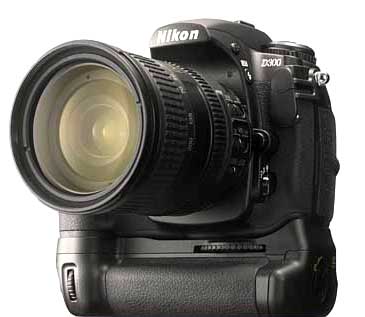 I'd get one
here.
I'd get one
here.
Introduction
As far as capabilities and features, the Nikon D300 is Nikon's second-best camera body available for sale today. It is second only to the mighty D3, which is several times the cost. The D3 is about to be replaced by the D3x, but it will remain a premium camera for professionals whose work demands the ultimate in performance and capabilities.
But, the D300 IS the best Nikon body when you compare the features to the cost. I say this because the D300 body is 90% (or more) effective as a D3, but costs a third the price. That's a price-to-performance ratio I can love.
This camera is as close to perfection as I have ever used in my entire life as a photographer. I have only one gripe about it, and it is something that Nikon should be able to fix via a firmware upgrade. If you are considering purchasing one of these, and you can afford it, by all means do so: you will love it.
Specifications
Maximum Resolution: 12.3MP (4,288 x 2,848) - This is slightly higher than the might D3's output. The difference is meaningless, but if it really matters to you, there you go. I like have more pixels so if I crop an image I retain lots of pixel information. You don't need all of the pixels as-shot, but if you throw away some pixels, like I do, then this is helpful.
Minimum ISO: 100 - This is great. Nikon is getting weird with their ISOs and it only goes down to ISO200 unless you enable a custom function, and then ISO100 is called "lo." Only thing that could be better would be ISO50, but you know if this had ISO50 I'd ask for ISO25.
Maximum ISO: 6,400 - This is awesome. Similar to the
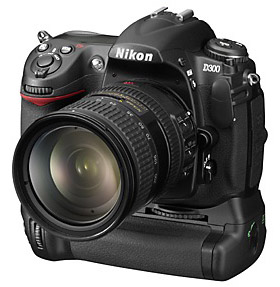 lower ISO bound it only lists up to 3,200 unless you turn
on a menu option, and then it calls these upper ISOs "hi."
lower ISO bound it only lists up to 3,200 unless you turn
on a menu option, and then it calls these upper ISOs "hi."
Vertical Grip: YES. I have a whole section on the grip below.
Meter weird lenses: YES - This camera can use your LensBaby lens or any other odd-ball lens you can physically attach to the camera.
AF works with AF lenses: YES - Like a real camera should!
Memory Card Type: CF type I and type II cards.
Top LCD Illumination: Yes - A pleasant addition when you find yourself in a dark theater or up before dawn to get a nice sunrise shot.
Shutter speeds: B, 30-1/8,000. 1/8,000 is insanely fast. I've only shot 1/4,000th I think one time, so this should hopefully suit 99.9999% of anyone who will ever think of using a camera.
Maximum Frame Rate: 6 or 8fps - This is an amazing number. Out of the box the D300 can do 6fps: WOW! If you get the optional vertical grip (and I highly recommend that you do) it continues doing 6fps on regular Nikon batteries, but if you put in AAs then it can crank up to 8fps. It caps you at 100 frames at any speed before you have to let your finger off the shutter button and press it again. It only takes a few iterations of this before you fill your memory card.
Buttons and dials: Outstanding. You can do anything you want, including programming two of the buttons on the front to display things or (when combined with a dial movement) change settings. Even though you'll spend little time in menus while shooting, Nikon has added a custom menu where you can program your most commonly used goodies. I wish they'd add this via firmware to older camera bodies. Oh, and the buttons have a pleasant rubberized feeling to them, nice.
Modes: M,A,S,P, and NO scene modes. This could mean a slightly tougher learning curve for an amateur shooter, but I see it as a forced learning experience. It is like a bike without the training wheels. If you learned to ride that way you learned more quickly how to do things like the big kids. Training wheels are fine, if you need them. If you've outgrown them then it is nice to not have them in the way.
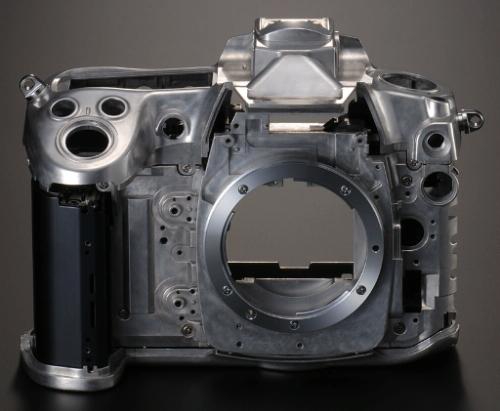
Inside of a D300 body.
Construction: As you can see from the above photo, this thing is built solid. It is very rugged and will stand up to the abuse that a professional demands their camera endure.
Other Goodies: Live View. This is the ability to use the camera's sensor to look through the lens to compose your shot. This makes the camera seem a little more "consumer" like since it can behave like your point-and-shoot digicam, but I really like it when I have the camera on a tripod so I don't have to get into a weird position just to look through the view finder. I use this now for all of my product photography and sometimes for macro work as well.
More Goodies: 51 AF points! I don't usually discuss the number of AF points in camera reviews since really, one is enough if you can recompose your shot. But, these 51 points are amazing and the camera's software is super smart to know what it is I probably want to have in focus. Unless I'm doing something super artistic, when I should be doing manual focus anyway, the camera gets it right nearly all the time. Bravo, Nikon.
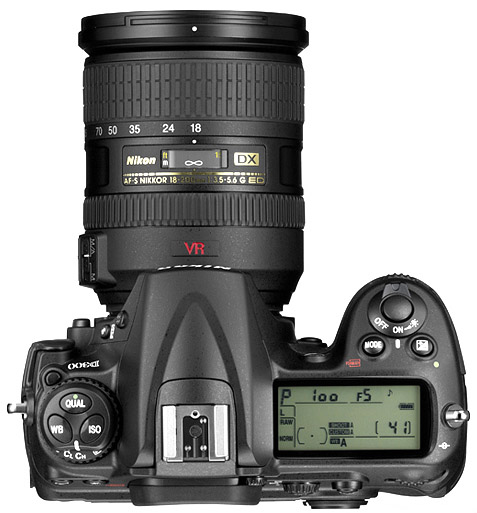 Even MORE Goodies: Active D-Lighting. The D-Lighting setup
in previous cameras was a waste of time. But, this new feature
isn't a bad thing at all. This increases the dynamic
range of the camera to something more like that of film. It
isn't a replacement to film at all, but just more like it.
The only trade-off
for this is speed and it will limit you to something like 9 or 10 frames
before you have to wait for the image processor to catch up. If
you're shooting sports, turn it off. If you're shooting nature
or weddings, try turning it on and see for yourself the
difference it makes in the sky.
Even MORE Goodies: Active D-Lighting. The D-Lighting setup
in previous cameras was a waste of time. But, this new feature
isn't a bad thing at all. This increases the dynamic
range of the camera to something more like that of film. It
isn't a replacement to film at all, but just more like it.
The only trade-off
for this is speed and it will limit you to something like 9 or 10 frames
before you have to wait for the image processor to catch up. If
you're shooting sports, turn it off. If you're shooting nature
or weddings, try turning it on and see for yourself the
difference it makes in the sky.
Extra Extra MORE Goodies: The once terrible 18-200 VR lens actually works on this camera. I don't know how they did it, but that lens (seen on the right attached to the D300) actually works on this camera body and manages to take decent pictures without all of the terrible optical issues I see on other Nikon bodies. Plus, with the D300's higher ISO capabilities it makes it a lot easier to deal with this relatively slow lens. This magic stuff allows that lens live up to its hype and I wish there was a way Nikon could add the optical correction technology to their other cameras via firmware. At first I was worried that the higher resolution of the D300 would just make those imperfections more noticeable (more pixels to capture the ugliness) but the magic beans inside of the D300 render images from an 18-200 VR lens as amazingly clear and sharp.
Vertical Grip
This grip is a new style compared to how Nikon has done these grips in the past. Overall, it is still a fine setup.
With the other grips you have to remove the battery cover door (you can slip this door into a handy slot on the grip for safekeeping) and then the two batteries go into the grip itself.
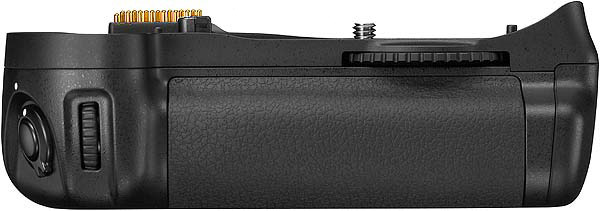
Nikon MB-D10, front.
This new grip keeps using the battery inside the D300 body and just attaches to the bottom of the camera. The second battery slides in on a caddy. One advantage of this setup is that the grip is thinner in your hand: something my wife prefers due to her smaller hand size.
Another advantage is that you can take the grip on or off in seconds rather than my record time with the old style of a minute due to fumbling with the battery door.
One disadvantage is that to get to the battery in the body you have to take the whole grip off of the camera. This is annoying if you're out in the field. It feels more like you're replacing computer memory than just simply taking out a battery.
Another small disadvantage is that with the introduction of the battery holder caddy thing you now have one more thing to lose or break.
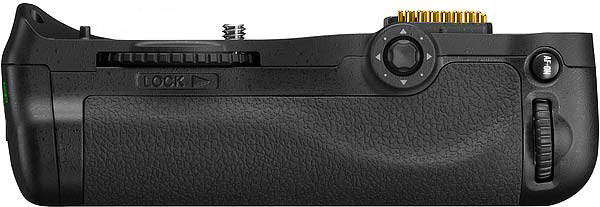
Nikon MB-D10, back.
You do get the option in a menu to pick which battery to use first. Before the camera defaulted to using the first battery inserted and if you wanted to manually control them you'd just pop them in and out to set the order.
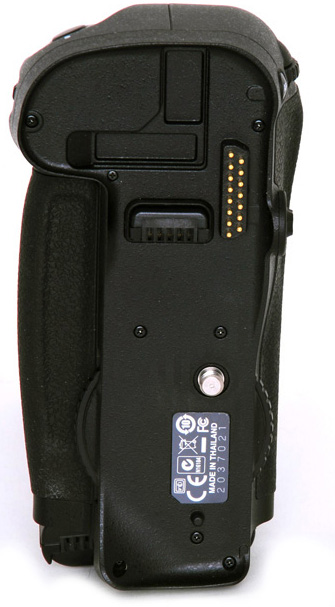
The grip also now has a selector button or D-Button like the camera body itself has. This is a handy idea so that while you're hand is on the vertical grip you can more easily navigate menus and more importantly navigate the AF selectors. My only gripe is that the button on the grip is stiff and is a small square. Had they used something like those laptop mouse-input things that look like a little eraser head, then it might be nicer on the hand.
The best would be to have a button even more like the pad on the D300 body itself. That button feels so good and navigates very easily.
I guess that had to make this button stiffer since they didn't include a lock for this button itself. But, the lock at D-Button on the D300 body itself also works as a lock for the input on the vertical grip.
Performance
In a word: WOW.
In two words: Life Changing.
Don't tell my wife, but I'm in love with this camera. Never before have I felt like a camera maker "got it" and produced a camera that let me do what I wanted when I wanted. From the moment you pick it up it feels like a rubber-coated brick in your hands but it acts like a tiger: ferociously fast and agile.
A good camera doesn't get in the way of you and it doesn't think it is smarter than the photographer using it. It just does what you tell it to and this camera hits a home run every time you send it up to bat.
With one small but annoying exception.
When you put the camera in mode "M" I expect it to be a "manual" mode, and everything should go to fully "manual" settings. It stands to reason since even in modes like "A" or "S" the camera keeps the manual WB settings I pick and doesn't run home to Auto-White Balance. But, Auto-ISO is kept on even when I switch to "M" mode. Why have Auto-anything in "M," isn't that a mutually exclusive concept??
Don't get me wrong, I love the Auto-ISO when I shoot in "A," or Aperture Priority. It is an outstanding feature. The way it works is that I set three variables: the ISO I really want, the maximum ISO I can live with, and the slowest shutter setting I can handle. The camera tries to use my ISO preference first, but if the shutter speed dips too low it cranks the ISO up (bounded by cap that I set) to keep me from doing something stupid.
Great, okay, fine. But, consider a studio setup where I have strobes and I have to use my hand-held light meter to judge the proper exposure. I set my camera to M for manual and set it like the meter told me to. Then when I click the shutter, the strobes fire. Since these lights are so bright I have to set my aperture to something like f/10 perhaps. Other than the 40-watt bulbs in the strobes to show me where they are pointed, there isn't much room-light, especially shooting at f/10. So, the camera looks at my low ISO200 setting and thinks I'm nuts to shoot at f/10 and cranks the ISO up to like ISO3200. I then take the picture, the strobes fire, releasing BRIGHT light, and I then capture a totally white and washed-out frame because the ISO wasn't what I set it to be.
Several times now I've just looked at my light meter and cursed at it for being so wrong! But really it was the camera being sill all along.
I don't have this problem with my D80 or even with a D200, but the D300 just can't seem to get this right.
I have to remember to go into a menu and turn off Auto-ISO when I go to manual mode. I'm getting better about remembering this, but I'm even worse at remembering to put it back when I'm done in the studio!
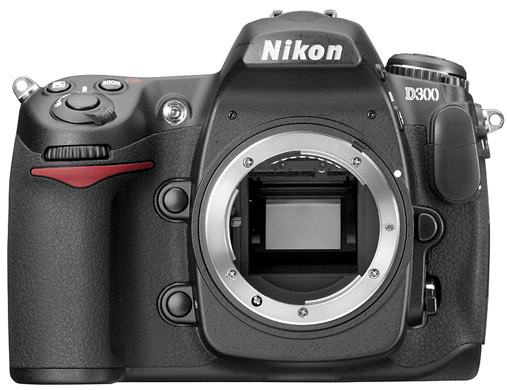
Nikon D300 Body, No Lens, No Body Cap
Alternatives
One alternative body would be the Nikon D3 or the D700, but the D3 costs several thousand dollars more, while the D700 is no garage-sale bargain either. And, their only real advantage is that they use a full-frame sensor.
Having a full-frame sensor allows for better low-light photography as higher ISOs are rendered with less noise. This is due to the simple fact that a large sensor can collect more light since its light receptors are spread out further. This has been a fact of photography for years and is why professionals used Medium and Large Format cameras for years: the clarity of a photo-receptive media is directly proportional to the size of the photo-receptive area.
If this matters to you, and you can live with using non-DX lenses like Nikon has been making for the past few years, then by all means, consider the D3 or the D700 as an (expensive) option.
Since the D300 is numbered as such you might think that a rival or comparable body would be the Nikon D200. Well, I consider the D300 to be so superior to a D200 as to not bother you with comparisons.
Besides, if you were looking for a D200, you should really consider a Nikon D80 instead since it is just a D200 in sheep's clothing.
Examples
Following are some sample photos to demonstrate the power of this camera and some general uses which will likely yield good results. If you shoot things like these, then this body may be a good one to think about adding to your camera bag.
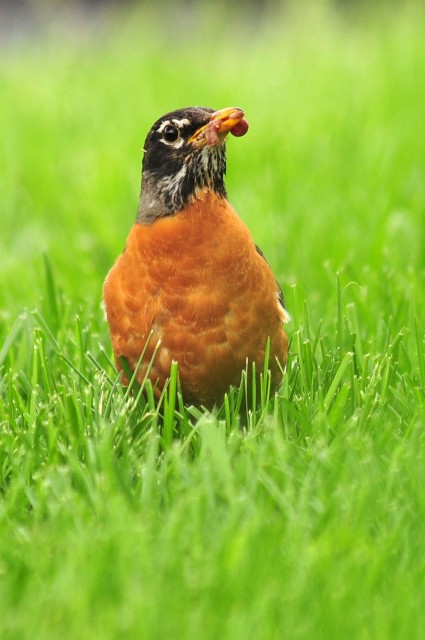
Bird with worm. 80-200 f/2.8D lens @ f/4.5, 1/500sec, ISO 200.

50mm f/1.4D @ f/1.4
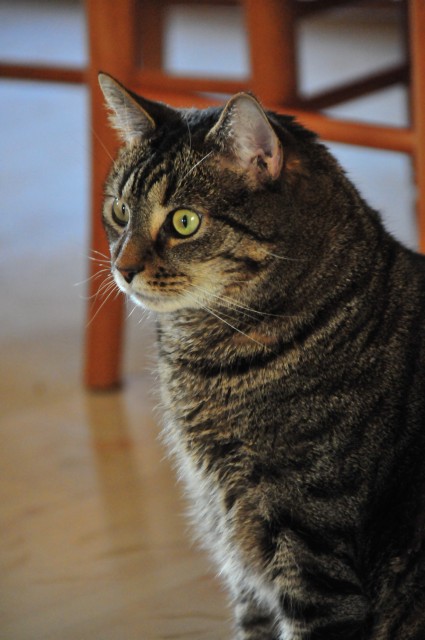
D300 set to ISO 3200 using only available window light. 18-200VR lens at f/5.6
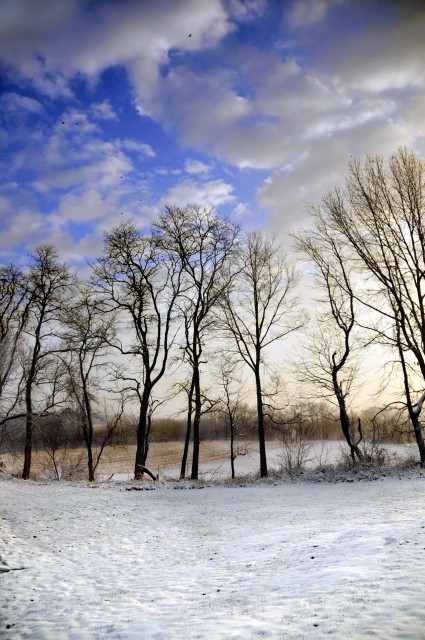
Check out that great blue sky and the crisp white snow. All thanks to the Active D-Lighting in-camera. The black specs you see in the sky are actually birds.

The D300 works well in the studio, once you remember to turn off Auto-ISO when you set the camera in Manual mode. Shot was done with ISO200 1/100s and the Nikon 18-135mm lens at 62mm and f/11.
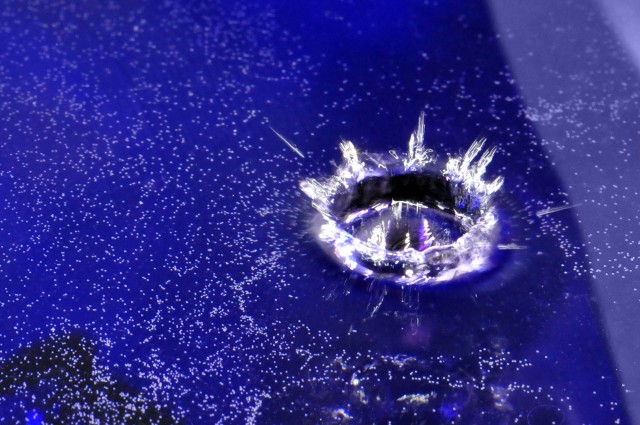
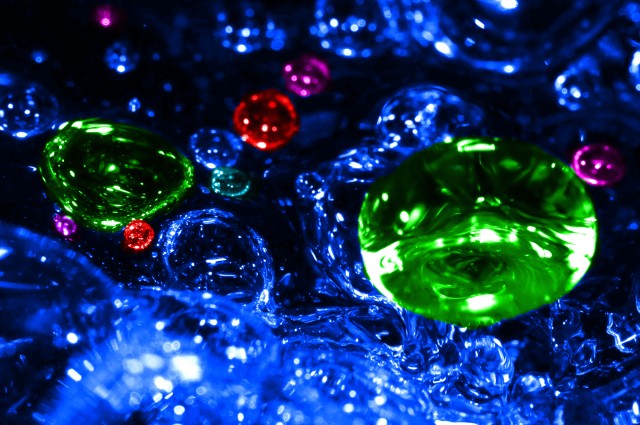
To see how I made the two photos above, check out this article on water drop photography.


Berries shot with a 105mm f/2.8 AFS VR lens on a warm fall day.
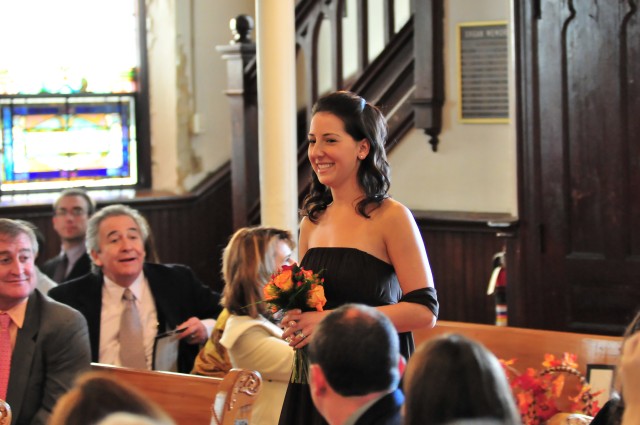
Bridesmaid entering at a wedding shot with 17-55mm f/2.8 lens.

D300 with 80-200mm f/2.8D lens.